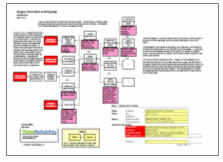It’s no surprise that we’ve written frequently about medication errors. It is estimated that medication errors harm approximately 1.5 million people annually in the U.S. We’ve outlined some of the many causes that contribute to medical errors at medical facilities, as well as some of the things that the public can do to reduce their risk of medication errors.
 Some of the more common issues that lead to medication errors include confusion on the label of the medication. It is estimated that almost half of Americans don’t understand the dosing instructions on their medication, leading to the potential for medication dosing errors. It’s no wonder, when “take one pill a day,” can be written in 44 different ways according to Dr. Ruth Parker. Additionally, many patients receive medication instructions that are either not in their primary language, or contain errors in the translation (see our previous blog about errors in translated medication instructions.)
Some of the more common issues that lead to medication errors include confusion on the label of the medication. It is estimated that almost half of Americans don’t understand the dosing instructions on their medication, leading to the potential for medication dosing errors. It’s no wonder, when “take one pill a day,” can be written in 44 different ways according to Dr. Ruth Parker. Additionally, many patients receive medication instructions that are either not in their primary language, or contain errors in the translation (see our previous blog about errors in translated medication instructions.)
It’s obvious that if almost half of people receiving medication instructions don’t understand them that something should be changed. An expert panel appointed by the US Pharmacopeial Convention (USP) has created national labeling standards in order to reduce medication errors caused by patient confusion with medication instructions. It is hoped that a final version of these rules is published by May 2012 and will then be implemented nationally. (Additionally, Canada is considering these standards as well.)
The proposed standards attempt to cover some of the most common errors in label decoding that lead to medication errors, including use of unfamiliar terms (such as Latin terms or jargon) and pictures instead of text (such as a picture of a crossed off alcohol bottle rather than “do not take with alcohol”). Additionally, medication instructions would be provided in the preferred language of the patient (and hopefully national standards will reduce the translation errors currently found on many medication bottles) in clearer font, with the information important to the medication found larger and on top and other information (such as the provider and pharmacy names) below and less emphasized.
Coming up with process improvements, such as these, with an expert panel allows consideration of many issues and points of view. When you’re looking at improvements in your organization, you already have an expert panel – it’s the people who do the work processes day in and day out. Additionally, information released by other organizations can be leveraged to provide solutions relevant to your organization. Take advantage of the expertise found in your organization when you are looking to improve processes – it will save time and money, and may even save lives.









